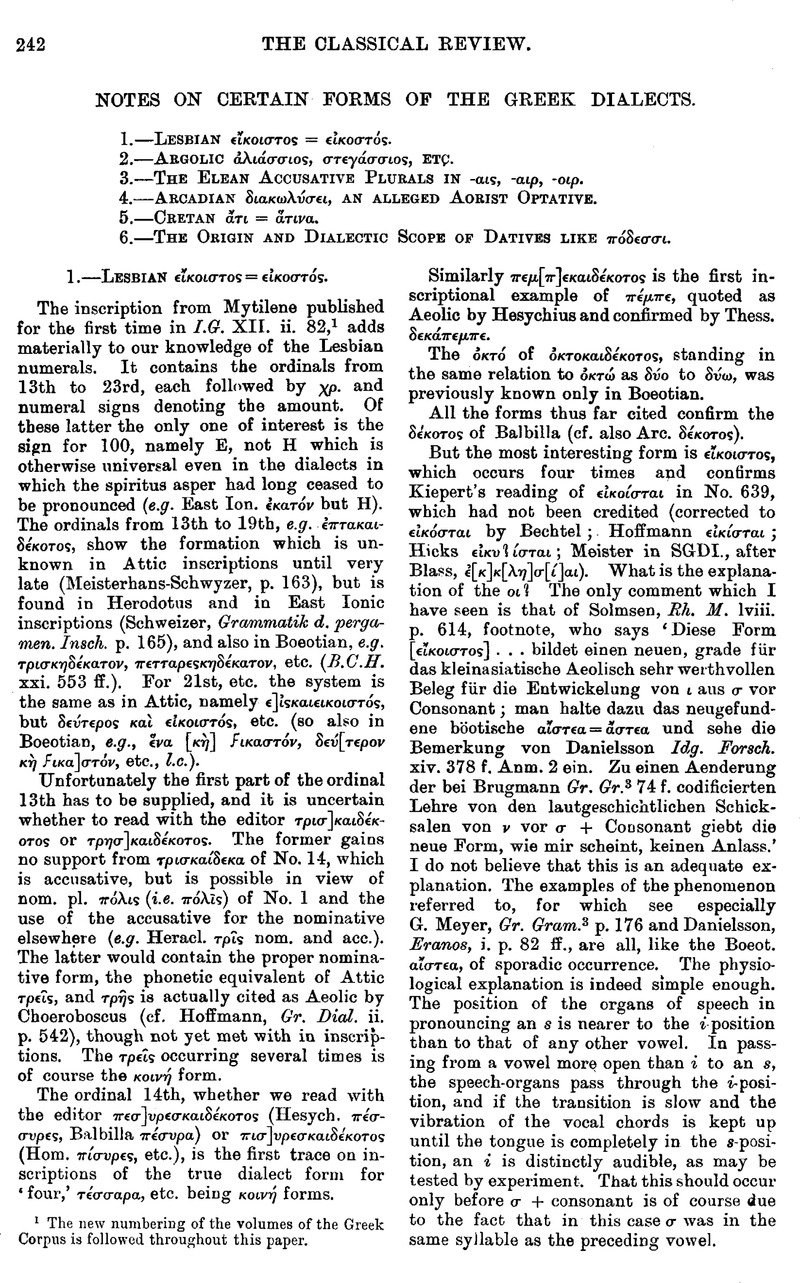Article contents
Notes on Certain Forms of the Greek Dialects
Published online by Cambridge University Press: 27 October 2009
Abstract

- Type
- Review Article
- Information
- Copyright
- Copyright © The Classical Association 1905
References
page 242 note 1 The new numbering of the volumes of the Greek Corpus is followed throughout this paper.
page 243 note 2 Since writing this I find that the same suggestion has already been made by Hoffmann, , Gr. Dial. iii. 427 Google Scholar.
page 243 note 2 This is probably what is suggested by Lattes a work cited by G. Meyer I.c., but inaccessible to me.
page 243 note 3
In Boeotian Θι⋯φειστος beside Θι⋯φεστος and Θεισπιε⋯ς beside Θεσπιε⋯ς;, which were formerly cited in the same connexion, the ει, as is now clear, represents not a diphthong but a close ε, the sound intermediate between ε and ι for which the sign is also used. This is in itself no bar to assuming connexion with the phenomenon in question. For that the evanescent i, which with a preceding α or o may produce the effect of a diphthong, should with a preceding ε, so near itself in quality, only make it somewhat closer, is just what we might expect from the relation of ![]() from
from ![]() from
from ![]() (see Goidanich, Le Sorti dei gruppi I.-E. -nj-, -mj-, -rj-, -lj- nell' Ellenismo, p. 20 ff.). But whether the ει in these cases is actually due to the following ω + consonant is rendered somewhat uncertain by the fact that such an ει is also found in other combinations, e.g.
(see Goidanich, Le Sorti dei gruppi I.-E. -nj-, -mj-, -rj-, -lj- nell' Ellenismo, p. 20 ff.). But whether the ει in these cases is actually due to the following ω + consonant is rendered somewhat uncertain by the fact that such an ει is also found in other combinations, e.g. ![]() , etc., indicating that a close pronunciation was characteristic of the Boeotian ε in general. See Brugmann, Gr. Gram.3 p. 28; Meister, Ber. Sächs. Gesell. 1899, p. 146; Sadée, De Boeotiae titulorum dialecto p. 80. Θεισπιε⋯σ, which is the regular spelling in inscriptions of Thespiae, is thought by Dittenberger to be a case of original ν. See Sadée, I.e.
, etc., indicating that a close pronunciation was characteristic of the Boeotian ε in general. See Brugmann, Gr. Gram.3 p. 28; Meister, Ber. Sächs. Gesell. 1899, p. 146; Sadée, De Boeotiae titulorum dialecto p. 80. Θεισπιε⋯σ, which is the regular spelling in inscriptions of Thespiae, is thought by Dittenberger to be a case of original ν. See Sadée, I.e.
page 245 note 1
Schulze, K.Z. 33, 126 ff. In this connexion note that Horn., Lesb. ⋯κ⋯λε-σσα for ⋯κ⋯λε-σα after ![]() is now found in Boeotian also (
is now found in Boeotian also (![]() in the same inscription which contains ⋯γ⋯ρασ-σιν; see reference above), another example of the Aeolic constituent in Boeotian.
in the same inscription which contains ⋯γ⋯ρασ-σιν; see reference above), another example of the Aeolic constituent in Boeotian.
page 244 note 2 -AIs occurs in Inschr. v. Ol. Nos. 2, 3, which Dittenberger (p. 4) regards as somewhat earlier than Nos. 4, 5, which have As. I have no hesitation in assuming -Ols beside -Als for the early period. Dittenberger's statement (p. 6) ‘Erst in dieser (i.e. the Democrates bronze of the first half of the third century) erstreckt sie (the diphthongal formation) auf die o-stämme der zweiten Deklination’ is verbally accurate, but gives a wrong impression of what the facts show. For it must be noted that there are no occurrences of o-stem accusatives in those inscriptions which have -Als not -As. There is then not the slightest ground for assuming that the conditions were different in the two declensions.
page 249 note 1 That is, as throughout in this paper, Doric in the narrower (and, still, more usual) sense, exclusive of N.W. Greek or ‘North Doric’
An addendum has been issued for this article:
- 1
- Cited by
Linked content
Please note an has been issued for this article.




